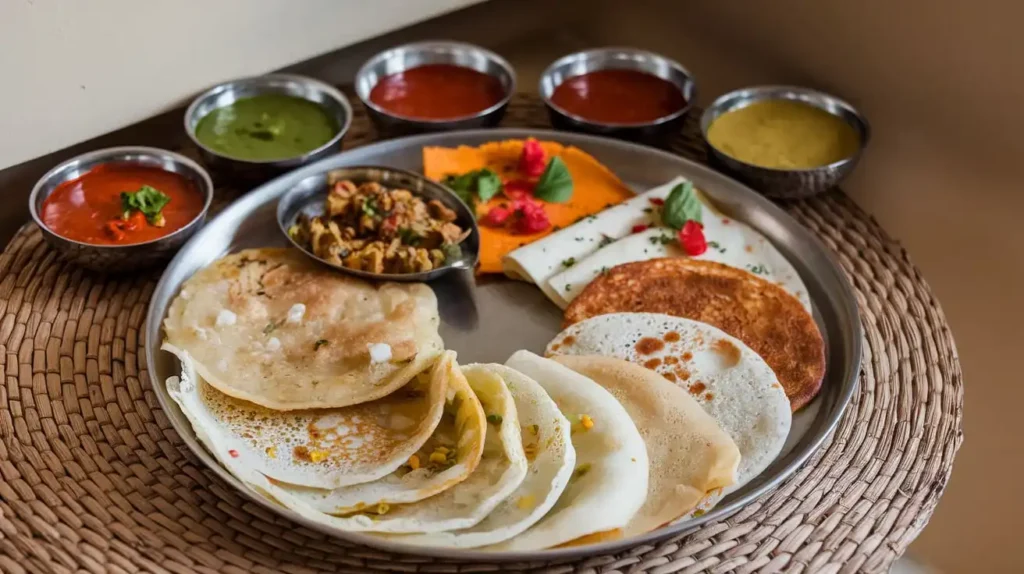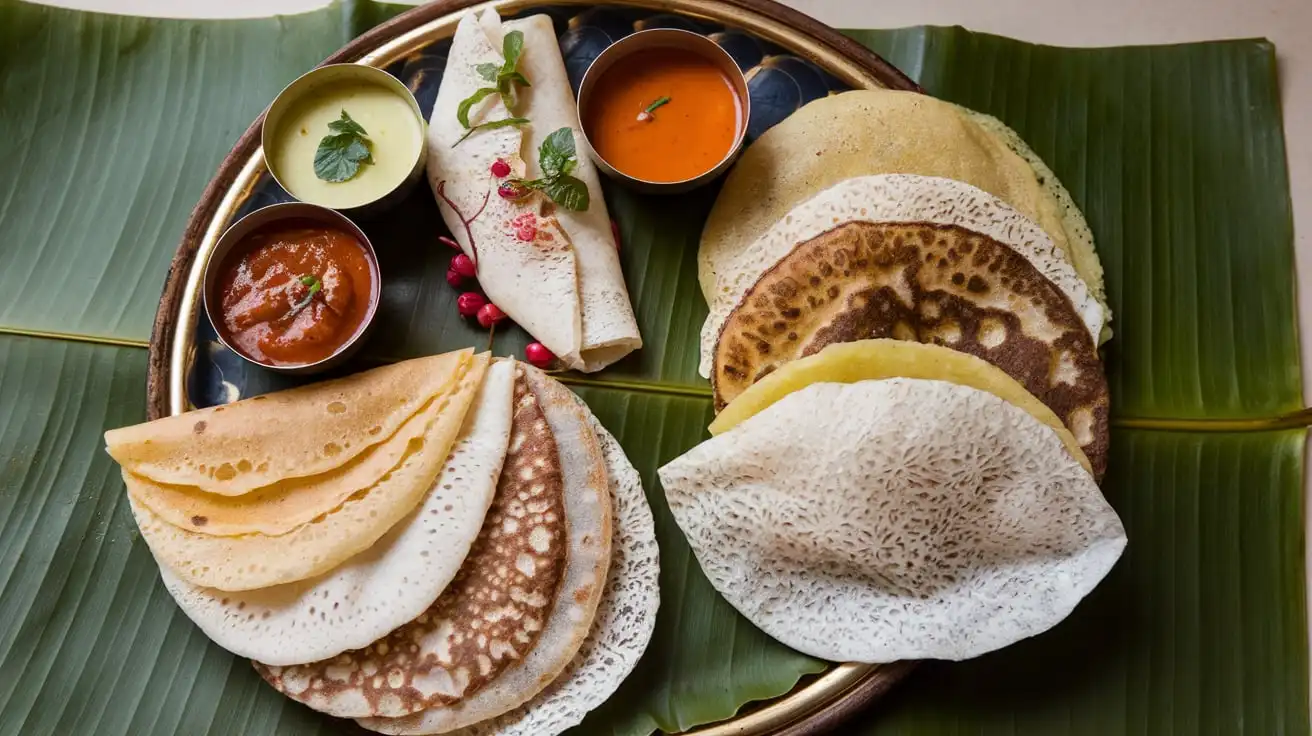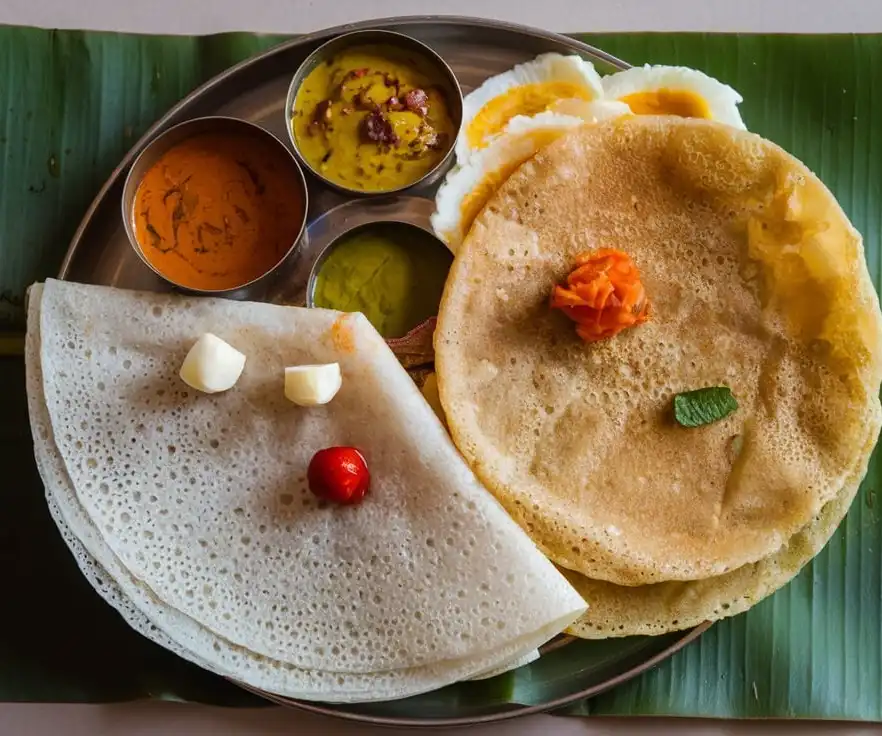Indian pancakes are a delightful treat that showcases the diversity and rich culinary heritage of India. Unlike traditional Western pancakes, these are often savory, packed with spices, and can be tailored to various tastes and dietary needs. Whether you’re looking for a quick snack, a hearty breakfast, or an exciting dinner option, Indian pancakes have something for everyone. Let’s explore the essence of these versatile creations.

Table of contents
Why You’ll Love This Recipe
Indian pancakes stand out because of their adaptability and bold flavors. They can be made gluten-free, protein-rich, or entirely plant-based, making them suitable for a wide range of diets. Their ingredients, such as chickpea flour, rice, and lentils, not only provide a unique taste but also offer numerous health benefits. Plus, these pancakes are simple to make, ensuring even beginner cooks can enjoy them.
If you’re also a fan of innovative breakfast ideas, don’t forget to check out this Gipfeli Recipe or the Easy Hotcake Mix Recipe.
Types of Indian Pancakes
Indian pancakes come in various forms, and each one beautifully reflects the unique culinary traditions of different regions. From crispy and light to thick and hearty, there’s a style of pancake for everyone to enjoy.
South Indian Dosa
Dosas are thin, crispy pancakes made from fermented rice and urad dal (black lentils). They are commonly served with coconut chutney and sambar, a spicy lentil soup, which together create a balanced and flavorful meal.
Uttapam
Similar to dosas, but slightly thicker, Uttapam is often topped with vegetables like onions, tomatoes, and chilies. This wholesome option is perfect for breakfast or brunch, as it provides both nutrition and a burst of vibrant flavors.
Besan Cheela
This North Indian favorite is made with This North Indian favorite is prepared with chickpea flour, a variety of spices, and optional vegetables for added texture. Not only is it protein-packed, but it’s also quick and easy to prepare, making it an excellent choice for a healthy snack or light meal. flour, spices, and optional vegetables. It’s a protein-packed pancake that’s quick and easy to prepare.
Pesarattu
A specialty from Andhra Pradesh, Pesarattu is made with green gram (mung beans), giving it a unique taste and high nutritional value. Often served with ginger chutney, it’s a savory delight that stands out among Indian pancake varieties.
| Type of Pancake | Key Ingredients | Regional Origin |
|---|---|---|
| Dosa | Rice, urad dal | South India |
| Uttapam | Rice, urad dal, vegetables | South India |
| Besan Cheela | Chickpea flour, spices | North India |
| Pesarattu | Green gram (mung beans) | Andhra Pradesh |
For other unique pancake ideas, you might enjoy these Mini Pancakes or Sheet Pan Pancakes from Mix.
Ingredients for Making Indian Pancakes
The ingredients for Indian pancakes vary depending on the type, but here’s a general breakdown:
Basic Ingredients
- Flours: The base of most Indian pancakes is made using chickpea flour, rice flour, or lentil flour. These flours provide a unique texture and nutritional value, making them perfect for both savory and wholesome recipes.
- Spices: To enhance the flavor, spices like turmeric, cumin, and green chilies are added. These ingredients not only add depth but also give the pancakes a distinct aroma and a slight kick.
- Liquids: Water or buttermilk is used to bind the ingredients and create a smooth batter. Buttermilk adds a slightly tangy flavor that complements the spices beautifully.
Optional Add-ons
- Vegetables: Incorporating finely chopped onions, tomatoes, or spinach adds both texture and nutrition. These vegetables also make the pancakes more colorful and appealing.
- Herbs: Fresh coriander and curry leaves bring a burst of freshness to the dish. They also infuse the batter with aromatic flavors that make every bite irresistible.
- Proteins: Paneer (Indian cottage cheese) or tofu is an excellent addition for boosting the protein content. These ingredients are perfect for turning pancakes into a filling and wholesome meal.
Another healthy twist on breakfast is the Healthy Pancake Mix.
| Ingredient | Purpose |
|---|---|
| Chickpea/Rice Flour | Base for the batter |
| Spices | Flavor enhancement |
| Vegetables | Texture and nutrition |
| Water/Buttermilk | The base for the batter |
Essential Tools for Preparation
When it comes to making Indian pancakes, having the right tools on hand can make the entire process a breeze. The right equipment ensures that your pancakes turn out perfect every time, from mixing the batter to flipping them on the pan.
Kitchen Equipment
- Non-stick Pan or Cast-Iron Griddle: These are essential for cooking your pancakes evenly and achieving the perfect texture. A non-stick surface makes flipping easier, while a cast-iron griddle retains heat well for crispy edges.
- Mixing Bowl and Whisk: A good mixing bowl paired with a sturdy whisk helps you prepare a smooth, lump-free batter effortlessly.
- Ladle: A ladle allows you to measure and spread the batter evenly, ensuring consistent pancake sizes.
- Spatula: A flat spatula is perfect for flipping pancakes without breaking them, which is especially useful for delicate varieties like dosas.
Optional Tools
- Blender or Grinder: To make fresh batter from soaked grains or lentils, a blender or grinder is indispensable. This tool is particularly helpful for recipes that require smooth, finely ground batter.
- Fermenting Container: If you’re making dosas or uttapams, a fermenting container comes in handy to provide the warm environment needed for proper fermentation.
By using these tools, you’ll not only simplify the cooking process but also elevate the quality of your Indian pancakes.
The Step-by-Step Guide to Making Indian Pancakes

Creating Indian pancakes is a straightforward yet rewarding process. Whether you’re preparing a dosa, besan cheela, or uttapam, these steps ensure success.
Preparing the Batter
The batter is the foundation of most Indian pancakes, and preparing it correctly is crucial for achieving the perfect texture and flavor. With just a few simple steps, you’ll be ready to cook delicious pancakes in no time.
- Soaking Ingredients: For dosa or uttapam, start by soaking rice and urad dal in water for 4-6 hours. This step softens the grains, making them easier to blend into a smooth batter. On the other hand, for Cheela, you can skip the soaking step and directly mix chickpea flour with water and spices, making it a quicker option.
- Grinding: Next, blend the soaked ingredients into a smooth paste using a grinder or blender. Gradually add water to achieve the desired consistency, which should be thick but pourable. This step ensures the batter is lump-free and easy to spread.
- Fermentation: Finally, allow the batter to ferment overnight in a warm place. Fermentation is essential for dosa and uttapam as it develops the characteristic tangy flavor and helps the pancakes rise slightly during cooking. For Cheela, fermentation isn’t necessary, making it a faster alternative.
By following these steps, you’ll have a versatile batter ready to create a variety of Indian pancakes!
Cooking Techniques
Cooking Indian pancakes involves simple techniques that bring out their flavor and texture.
- Preheating the Pan: Heat a non-stick or cast-iron pan over medium heat. Lightly grease it with oil.
- Spreading the Batter: Pour a ladleful of batter onto the pan and spread it in circular motions to form a thin or thick pancake, depending on the type.
- Cooking: Allow the pancake to cook until bubbles form or the edges lift slightly. Flip and cook the other side if needed.
- Serving: Serve hot with accompaniments like chutney, sambar, or pickles.
| Step | Description |
|---|---|
| Soaking Ingredients | Prepares grains/lentils for blending |
| Grinding | Creates a smooth, spreadable batter |
| Fermentation | Develops flavor and texture (for dosa/uttapam) |
| Cooking | Achieves crispy or soft pancakes, depending on the recipe |
For more inspiration, try these creative recipes: Crepes with Pancake Mix or Pancake Bites.
Regional Inspirations for Indian Pancakes
Indian pancakes vary widely across the country, with each region offering its own unique take that reflects local ingredients and culinary traditions. From South India’s crispy dosas to Maharashtra’s hearty thalipeeth, there’s so much to explore.
South Indian Dosa and Variations
To begin with, South Indian dosas are a classic favorite. Classic Dosa is thin, crispy, and bursting with flavor, typically served alongside coconut chutney and sambar to create a balanced meal. For something heartier, Masala Dosa includes a spiced potato filling, adding richness and satisfaction to every bite.
North Indian Favorites
Moving to the north, Besan Cheela is a light yet protein-packed pancake made from chickpea flour, with the added zest of carom seeds and cilantro. Meanwhile, Paneer Cheela takes this up a notch by incorporating crumbled paneer, offering a creamy and nutritious twist.
Regional Specialties
In Andhra Pradesh, Pesarattu is a standout choice. Made with mung beans, it’s both nutritious and flavorful, especially when paired with zesty ginger chutney. Finally, Maharashtra’s Thalipeeth showcases a multi-grain base enriched with spices, chilies, and herbs, making it a hearty and earthy delight.
By exploring these regional variations, you’ll gain a deeper appreciation for the versatility and creativity behind Indian pancakes.
Add-ons and Toppings
- Vegetables: For added texture and nutrition, mix finely chopped onions, spinach, grated carrots, or zucchini directly into the batter. These vegetables not only enhance the flavor but also make the pancakes more colorful and appetizing.
- Spices and Herbs: To elevate the taste, try adding fresh cilantro, curry leaves, or a pinch of asafoetida (hing). These ingredients infuse the batter with aromatic flavors that are distinctively Indian.
- Cheese or Paneer: For a creamy twist, sprinkle shredded cheese or crumbled paneer on top of the pancake while it’s still cooking. This adds richness and transforms the dish into a more indulgent treat.
By experimenting with these add-ons and toppings, you can create a variety of pancakes that are both delicious and uniquely yours.
| Add-on | Effect |
|---|---|
| Grated Vegetables | Boosts nutrition and texture |
| Fresh Herbs | Adds freshness and aroma |
| Cheese or Paneer | Introduces richness and flavor |
Dietary Adjustments
When it comes to Indian pancakes, making dietary adjustments is simple and allows you to enjoy them in a way that fits your lifestyle. With a few thoughtful tweaks, you can make these pancakes even healthier and more suitable for various dietary needs.
Gluten-Free Option
To start, you can use naturally gluten-free flour like rice, chickpea, or millet flour as a base for your batter. This not only makes the pancakes safe for those with gluten sensitivities but also adds unique flavors and textures to the dish.
Protein Boost
Additionally, for those looking to increase their protein intake, consider adding ingredients like mung beans, tofu, or quinoa flour. These options make the pancakes more filling and turn them into a balanced meal that’s perfect for breakfast, lunch, or dinner.
Low-Oil Cooking
Lastly, if you want to reduce oil without sacrificing taste, a non-stick pan is a great choice. This allows you to cook the pancakes evenly while using minimal oil, making them lighter and healthier.
With these adjustments, you can customize Indian pancakes to align perfectly with your dietary preferences while still enjoying their delicious flavors.
Sweet Pancake Variations
Though traditionally savory, Indian pancakes can also be made sweet for a delightful dessert or breakfast treat:
- Jaggery Pancakes: Mix jaggery (unrefined sugar) into the batter along with cardamom for a caramelized flavor.
- Banana Pancakes: Mash ripe bananas into the batter for natural sweetness and a soft texture.
If you enjoy experimenting with breakfast, don’t miss the Krusteaz Pancake Mix for a quick and delicious base to try new variations.
Serving Suggestions for Indian Pancakes
Indian pancakes are best enjoyed with flavorful accompaniments that not only enhance their taste but also provide a perfect balance to their textures. Whether you prefer traditional pairings or modern twists, there’s no shortage of options to explore.
Traditional Accompaniments
- Coconut Chutney: This smooth and creamy side, made with fresh coconut, green chilies, and roasted lentils, is a classic choice that complements the subtle flavors of dosas and uttapams.
- Sambar: A tangy and spicy lentil soup, sambar is often served with South Indian pancakes, adding warmth and zest to the meal.
- Pickles: Indian-style pickles provide a tangy and spicy kick, making them a delightful pairing for savory pancakes like besan cheela.
Modern Pairings
- Yogurt Dips: Herbed yogurt or spiced raita offers a refreshing contrast to the bold flavors of the pancakes.
- Avocado Salsa: This fusion twist pairs beautifully with besan cheela or uttapam, adding a creamy and slightly tangy element.
- Hummus: A creamy and nutty spread, hummus works especially well with mung bean pancakes, creating a perfect blend of textures and flavors.
By trying these accompaniments, you can elevate your Indian pancakes into a complete and satisfying meal that suits both traditional and contemporary tastes.
Making Indian Pancakes a Crowd Favorite
Indian pancakes are ideal for gatherings, family breakfasts, or even a fun cooking session with friends. With a few thoughtful touches, you can turn them into a memorable and interactive dining experience.
Tips for Entertaining with Indian Pancakes
- Create a DIY Pancake Station: Set up a table with bowls of batter and a variety of toppings like vegetables, cheeses, and spices. Let your guests customize their pancakes for a fun and engaging activity.
- Offer a Variety: To cater to diverse tastes and dietary preferences, prepare a mix of dosas, besan cheelas, and uttapams. This ensures there’s something for everyone.
- Pair with Drinks: Complete the meal by serving refreshing drinks like masala chai or spiced buttermilk, which add an authentic Indian touch and enhance the overall experience.
Kid-Friendly Ideas
Children love pancakes, and with a little creativity, you can make Indian pancakes their favorite treat:
- Mini Pancakes: Prepare bite-sized versions of uttapam or cheela, which are perfect for kids to handle and enjoy.
- Sweetened Options: Add natural sweeteners like jaggery or honey to the batter to create a subtly sweet pancake that kids will find irresistible.
- Fun Shapes: Use molds to create star- or heart-shaped pancakes, making them both appealing and exciting for little ones.
For more kid-friendly inspirations, explore Pancake Bites and see how easy it is to make breakfast enjoyable for the entire family!
Frequently Asked Questions About Indian Pancakes
Indian pancakes are typically savory, featuring bold spices and sometimes a fermentation process that adds a tangy flavor. In contrast, Western pancakes are sweet and rely on baking powder or soda for leavening, making them fluffier.
Many Indian pancakes are naturally gluten-free because they use flour like chickpea, rice, or lentil instead of wheat. However, it’s always a good idea to double-check the recipe to ensure it meets specific dietary requirements.
Absolutely! Recipes like besan cheela and thalipeeth skip the fermentation step entirely, making them quick and easy to prepare. This is perfect for when you’re short on time but still crave authentic flavors.
For traditional pairings, try coconut chutney, tangy sambar, or spicy pickles to enhance the flavors. Alternatively, you can serve them with yogurt dips or avocado salsa for a modern and refreshing twist.
To keep your pancakes fresh, place them in an airtight container and store them in the fridge for up to three days. When you’re ready to eat, simply reheat them on a pan to restore their texture and flavor.
Yes, you can freeze dosa or uttapam batter for up to a month. Just thaw it overnight in the refrigerator, and it will be ready to use the next day for delicious homemade pancakes.
Conclusion
Indian pancakes are a celebration of flavor, tradition, and versatility. Whether you’re enjoying a crispy dosa, a hearty uttapam, or a quick besan cheela, these pancakes bring warmth and satisfaction to any table. By experimenting with ingredients, variations, and accompaniments, you can create endless culinary possibilities. So why not dive into the world of Indian pancakes and share the joy with family and friends?
For more delightful breakfast ideas, check out Healthy Pancake Mix or Sheet Pan Pancakes from Mix. Happy cooking!

Indian Pancakes
Ingredients
- 1 cup rice flour or chickpea flour
- ½ cup lentils optional, for dosa or pesarattu
- ½ teaspoon turmeric powder
- ½ teaspoon cumin seeds or ground cumin
- 1-2 green chilies finely chopped
- 1½ cups water or buttermilk
- ½ cup finely chopped vegetables onions, spinach, carrots – optional
- ½ cup crumbled paneer or tofu optional
- Salt to taste
Instructions
- In a mixing bowl, combine the flour, spices, and salt.
- Gradually add water or buttermilk while whisking to create a smooth, lump-free batter.
- Stir in optional vegetables or paneer for added flavor and texture.
- Heat a non-stick pan over medium heat and lightly grease it with oil.
- Pour a ladleful of batter onto the pan, spreading it evenly in a circular motion.
- Cook until bubbles form on the surface and the edges lift slightly. Flip and cook the other side until golden.
- Serve hot with coconut chutney, sambar, or pickles.
Notes
- Adjust the consistency of the batter for thicker or thinner pancakes.
- Ferment the batter overnight for a tangy flavor if desired.
